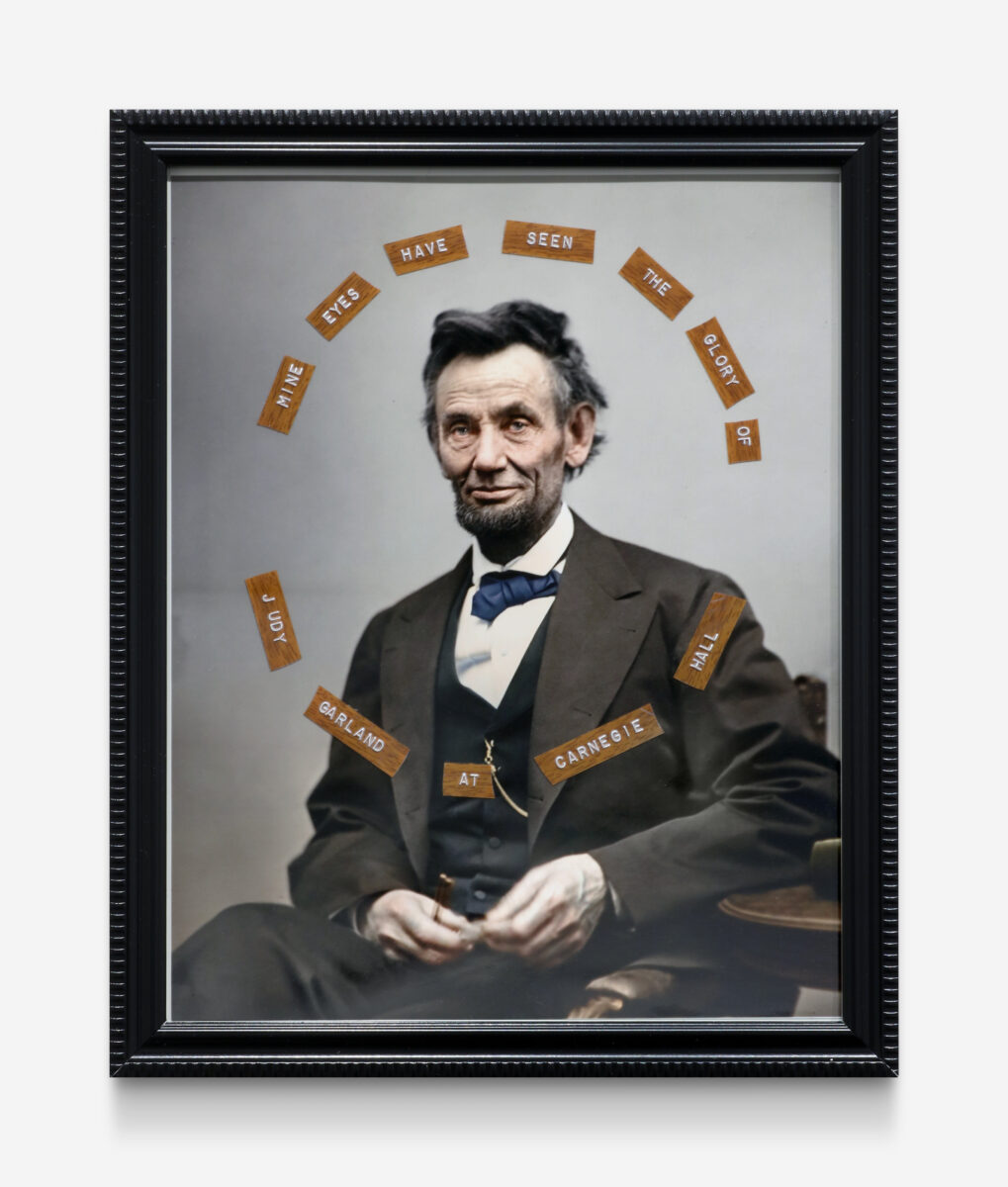Cary Leibowitz’s “Mine Eyes Have Seen the Glory of Judy Garland at Carnegie Hall,” uses as its support a colorized version of a photograph of Abraham Lincoln taken by Alexander Gardner on February 3, 1865. The Lincoln photo is available as a free, high resolution download from the USA’s Library of Congress website. The artist printed the image commercially and then applied to its surface (with “label-maker” tape) the text that also serves as the work’s title.
Combining (1) the tragic/heroic imagery of Abraham Lincoln, (2) the reference to Judy Garland who, in a different context, is also seen as both tragic and heroic, (3) the fact that Garland thought that “The Battle Hymn of the Republic” was one of the best written songs of all time, and (4) Leibowitz’s use of the inexpensive materials of label-maker tape and a free jpeg, “Mine Eyes Have Seen the Glory of Judy Garland at Carnegie Hall” proudly champions bravery in the face of adversity through time, all while allowing questioning of identity, success, and purpose to continue.
For a deeper understanding of the photo of Lincoln, Garland at Carnegie Hall, and “The Battle Hymn of the Republic” (the song from which the lyrics, “Mine eyes …” were borrowed), see below:
Lincoln
- November 8, 1864: Election Day in the USA. Abraham Lincoln handily defeated George McClellan.
- February 1, 1865: Lincoln signs the resolution submitting to the States the 13th Amendment to the Constitution, for ratification.
- February 3, 1865: Lincoln attended the “Hampton Roads Peace Conference” with Secretary of State William Seward and two members of the Confederate Cabinet. Historians, to this day, disagree about the strategy, purpose, and successfulness of the event.
- February 5, 1865: Alexander Gardner takes a photograph of Lincoln, seated and holding his glasses and a pencil. February 9, 1865: Lincoln submits a letter to the Committee of Congress Reporting the Result of the Electoral Vote Count stating the following: “With deep gratitude to my countrymen for this mark of their confidence; with a distrust of my own ability to perform the duty required under the most favorable circumstances, and now rendered doubly difficult by existing national perils; yet with a firm reliance on the strength of our free government, and the eventual loyalty of the people to the just principles upon which it is founded, and above all with an unshaken faith in the Supreme Ruler of nations, I accept this trust. Be pleased to signify this to the respective Houses of Congress. Abraham Lincoln”
- April 15, 1865: Lincoln dies following his shooting by John Wilkes Booth on the night of 04/14/1865.
Garland
- April 23, 1961: “Judy Garland made history. That’s no hyperbole. Surrounded by a throng of ecstatic fans (3,165 to be exact), the legendary performer delivered a concert in Carnegie Hall the live recording of which became, upon release, an unlikely pop cultural phenomenon. Judy at Carnegie Hall, the two-disc set that captured all 25 numbers she performed that night, went on to spend more than 70 weeks on the Billboard charts, win four Grammy Awards — including Album of the Year (making it the first live music album and the first album by a female performer to win the category) — and become, in the process, the fastest-selling two-disc set in history. What the recording highlights, and what’s made it an enduring classic in a class of its own, is the palpable connection between the songstress and her fans. “Indeed,” The New York Times reported in its review of the evening’s proceedings, “what actually was to have been a concert — and was — also turned into something not too remote from a revival meeting.” By looking at her song choices, her stage banter, the album’s cultural impact, and her place in the gay pantheon, Judy’s palpable connection with her fans is precisely what her Capitol Records’ two-disc album captured.”
—Manuel Betancourt
- In discussing Judy Garland’s camp appeal, gay film scholar Richard Dyer has defined camp as “a characteristically gay way of handling the values, images and products of the dominant culture through irony, exaggeration, trivialisation, theatricalisation and an ambivalent making fun of and out of the serious and respectable.” Garland is camp, he asserts, because she is “imitable, her appearance and gestures copiable in drag acts.” He calls her “ordinariness” in her early MGM films camp in their “failed seriousness” and her later style “wonderfully over-the-top.”
The Battle Hymn of the Republic
The “Battle Hymn of the Republic”, also known as “Mine Eyes Have Seen the Glory” or “Glory, Glory Hallelujah,” was written by Julia Ward Howe. Howe adapted her song from the popular soldiers’ song, “John Brown’s Body” in November, 1861, and first published it in The Atlantic Monthly in February, 1862. In contrast to the thoroughly early lyrics of the soldiers’ song, her version links the Union cause with secular God’s vengeance at the Day of Judgment.
To view Garland singing the song, click here [youtube video]
